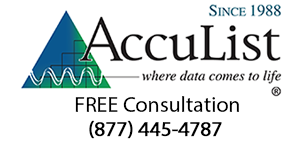2019 Promo Products Embrace USA-Made, Retail Quality
The “2019 Ad Impressions Study” by the Advertising Specialty Institute has many nuggets to help AccuList’s promotional products marketing clients woo targeted buyers. For example, promo products purveyors can point out how their items beat other ad media not only with high ROI, thanks to a cost per impression as low as a tenth of a cent, but also high impact, with consumers under age 55 preferring promo products over all other media for advertising, including newspapers, radio, magazines, television, internet and mobile. In fact, consumers are nearly 2.5 times more likely to have a positive opinion of promotional products compared with online advertising, per ASI.
Not All Promo Products Are Created Equal
When it comes to consumers’ favored promotional products, ASI’s study shows the highest ownership for writing instruments (89%), drink ware (88%) and T shirts (80%). Looking at numbers alone, outerwear is a big winner with the most impressions (6,100), the greatest memorability (85% of consumers remember the advertiser giving branded apparel), and the greatest staying power (outerwear is kept an average of 16 months compared with 9 months for writing implements, for example). But winning even with a popular category means keeping up with trends. Among the latest spotted by Promo Marketing Magazine at the 2019 Promotional Products Association International (PPAI) Expo is the boost in re-usable, environmentally friendly products now that cities and states are banning single-use plastic bags and straws. A return to natural and vintage is not surprising in this anti-plastic mode, with a rise in the popularity of wooden pieces, from cutting boards to awards. Plus, multi-function items continue to grow in popularity, with suppliers adding tech functions to classic promotional items, so that water bottles double as Bluetooth speakers and business card holders can be used to prop phones.
Design-wise, Think Retail Quality, Bundling, USA-Made
The marketers at Delta Marketing Group (DMG) get even more specific about trends in design affecting a range of product categories. As more retail brands become available as customizable promotional products, even non-brand items are starting to emulate the retail look and feel, the agency points out. Quality over brand-logo-blasting also is taking hold, for example with branded apparel using small embroidered patches, subtle custom tags, and understated tone-on-tone colors instead of large logo imprints. Creative materials and refined finishes are forecast to come to the fore in 2019, with bright colors, matte and soft-touch finishes, and heathered and burlap fabrics. DMG also predicts that gift sets packaging several cohesive promotional items together will peak in 2019. Watch for desktop accessories to gain popularity, such as branded mousepads, coasters and phone stands, etc., often bundled as a new-employee or a new-student welcome kit. Plus, with the advent of experiential marketing for events, promotional products are trending toward event-specific giveaways that complete the brand’s event experience. Finally, the made-in-the-USA trend stays strong, per ASI’s study. About 53% of consumers have a more favorable opinion of an advertiser if the promotional product is made in the U.S. versus elsewhere, and that sentiment is especially strong in New England, where 73% of consumers prefer buying made-in-the-USA items. For details from the ASI study, see https://www.asicentral.com/news/web-exclusive/january-2019/2019-ad-impressions-study/


